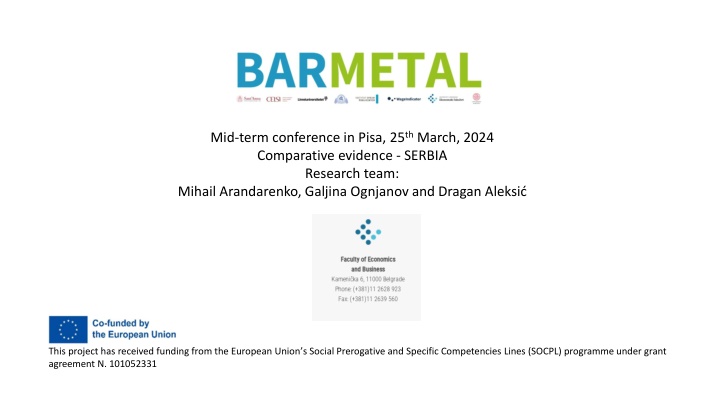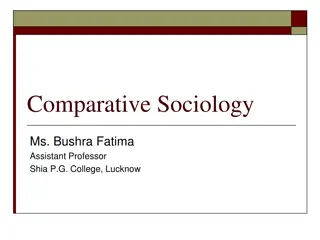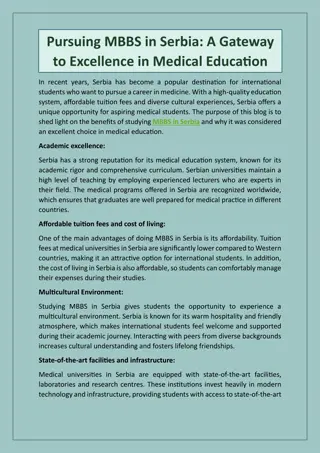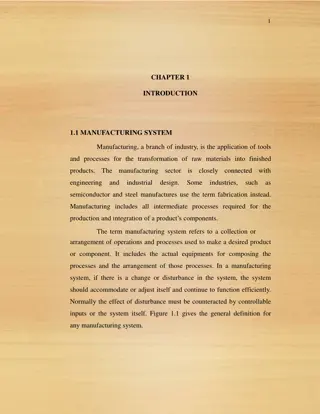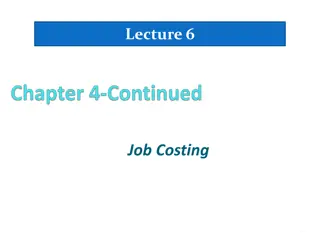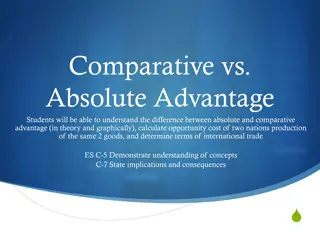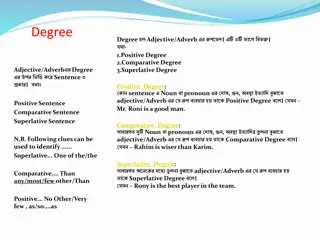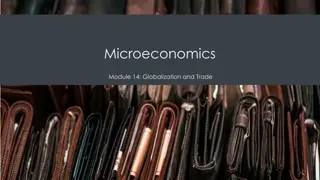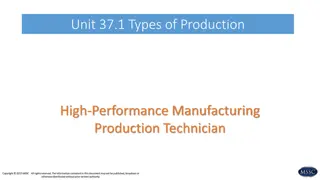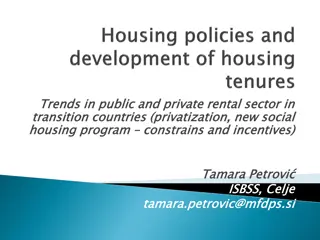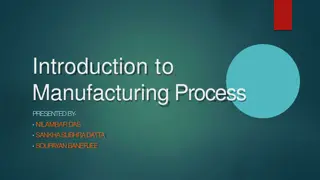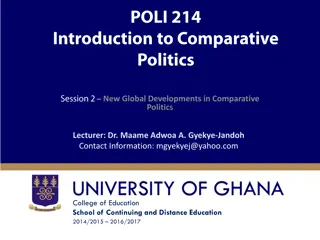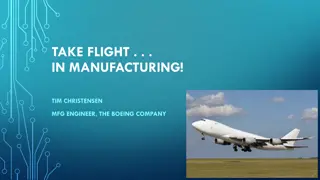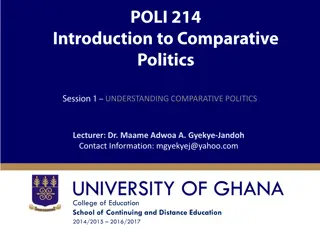Comparative Evidence in Serbia's Manufacturing Sector
The mid-term conference in Pisa on 25th March 2024 sheds light on Serbia's involvement in global value chains, particularly focusing on the Metal sector. It explores the impact of Foreign Direct Investments, the country's position in Global Value Chains, and the trends in GVC participation index. The study highlights the importance of imported intermediate inputs and the shift towards later stages of production within global value chains in Serbia.
Download Presentation

Please find below an Image/Link to download the presentation.
The content on the website is provided AS IS for your information and personal use only. It may not be sold, licensed, or shared on other websites without obtaining consent from the author.If you encounter any issues during the download, it is possible that the publisher has removed the file from their server.
You are allowed to download the files provided on this website for personal or commercial use, subject to the condition that they are used lawfully. All files are the property of their respective owners.
The content on the website is provided AS IS for your information and personal use only. It may not be sold, licensed, or shared on other websites without obtaining consent from the author.
E N D
Presentation Transcript
Mid-term conference in Pisa, 25th March, 2024 Comparative evidence - SERBIA Research team: Mihail Arandarenko, Galjina Ognjanov and Dragan Aleksi This project has received funding from the European Union s Social Prerogative and Specific Competencies Lines (SOCPL) programme under grant agreement N. 101052331
Structural and institutional setting: Employment and Wages Share of total employment (LFS, 15+) 7.00% 20.00% 6.00% 19.00% 5.00% 18.00% 4.00% 3.00% 17.00% 2.00% 16.00% 1.00% 0.00% 15.00% 2012 2013 2014 2015 2016 2017 2018 2019 2020 2021 2022 C24 C25 C28 C29 C Manufacturing (right axis) Share of total employment (CROSO, 15+) 7.00% 23.00% 6.00% 21.00% 5.00% 4.00% 19.00% 3.00% 2.00% 17.00% 1.00% 0.00% 15.00% 2012 2013 2014 2015 2016 2017 2018 2019 2020 2021 2022 C24 C25 C28 C29 C Manufacturing (right axis)
Structural and institutional setting: Share in GVA and total exports Share (%) in total Value Added, 2021 Share (%) in total Exports, 2021 25.2 6.6 1.6 1 3.6 3 12.4 3.3 5.3 30.8 69.2 74.8 C 24 C 25 C 28 C 29 C Manufacturing Other C 24 C 25 C 28 C 29 C Manufacturing Other
Position in GVC Serbia is a typical small emerging economy that relies on export-led growth (Radulovic, B., 2021) Owing to its geographic position, skilled workforce, openness and solid infrastructure Serbia has taken part in GVC (Kovacevic, M., Stancic, K., Jelic, S., 2021). In 2015 Serbia exhibited high degree of GVC participation. The above-average growth of production and employment in the Metal sector in the last decade owes to the sharp increase in Foreign Direct Investments (FDIs). The Metal sector in Serbia has become very attractive for the FDIs because of relatively low labour costs and high Government subsidies. One recent study found that more than one-third of the country's FDIs during the 2016-2020 time span went to the portion of Manufacturing that covers three observed sub-sectors (but also the Manufacture of computer, electronic and optical products sub-sector). Additionally, over half of all newly created jobs by the FDIs in the same period are located in these three sub-sectors (Arandarenko et al, 2021). According to a study (Zajc Kejzar, K., Raskovic, M., 2020). in 2005-2015 Serbia witnessed a significant increase in backward participation coupled with downstream movement along the GVCs, particularly with regard to basic metals and fabricated metal products. Serbia increasingly specialises in later stages of production within global value chains, relying strongly on imported inputs (Bjelic et al, 2020). There has been a sharp increase in the significance of the backward component of the GVC participation index, whereby in some industries (including Metal Products) this component becomes the main driver of their involvement in global production chains, indicating the growing relative importance of imported intermediate inputs used to generate output for export. According to the Survey by Vienna Institute for International Economic Studies (2021) Serbia shows a larger share of incorporated foreign value added in their exports than is the share of their value added in foreign exports. The largest share of foreign value added in the total exports is found in six divisions of Manufacturing, including Metal subsectors: Manufacture of motor vehicles, trailers and semitrailers, Manufacture of basic metals, Manufacture of machinery and equipment n.e.c (Kovacevic, M., Stancic, K., Jelic, S., 2021). Even though the exports are on the increase, the value added/GVA growth in certain divisions show falling trends (Manufacture of motor vehicle and trailers, Manufacture of electrical equipment), which may indicate unfavourable status in global value chains (at their bottom line), where value added is not created and only products assembling is carried out.
Industrial relations system Industrial relations in Serbia are regulated by the comprehensive body of labour legislation. Trade Unions are established on all three levels. Trade Union density has been decreasing since 2000, reaching around 25%. Adjusted bargaining coverage rate is at around 30%. Employer organization density 25% (OECD and AIAS, 2021) Representativeness of workers' and employers' associations remains the primary constraint hindering possibilities for collective bargaining. Two Confederations of Trade Unions and one Employers Associations are representative thus participate in SEC. General collective agreement is non-existent (statutory minimal wage applies), sectoral collective agreement for metal sector has also not been negotiated, whereas collective bargaining on company level are mostly practiced within large companies. SERBIA Characteristics of bargaining regime Single channel Trade Unions only Multy level/Multi tier General/sectoral/company Centralisation/decent ralisation Statutory minimal wage, Extension mechanism applies Dominant level in Metal Sector Company
DAD: development, challenges and the role of collective bargaining Industrial Policy Strategy of the Republic of Serbia for 2021-2030 addresses the issues of education, fostering innovation, digital transformation, investment, infrastructure, internationalisation and circular economy. Smart Specialisation Strategy of the Republic of Serbia for the period 2020-2027 which incorporates vertical (sectoral) policies further pointing at the relevance of DAD, specificaly for metal sector (machinery and equipment manufacturing) as one of four priority sectors. As part of accession process, Ministry for Environmental Protection of the Republic of Serbia formed the Special Working Group for Circular Economy in support to private companies thus facilitating transformation of their traditional business models towards circular economy: Industry 4.0 and DAD present narratives in public discourse, advocated within both academic and professional circles. The role of trade unions in these processes is still rather weak. Governmental initiatives for DAD in the metal sector are predominant. Accesion process and transposition of the EU regulatory and strategic documents. The manufacturing industry continues to be the single largest sector in terms of its share of GDP, at 13% in 2021. Roadmap for Circular Economy in Serbia 2020, An export-oriented sector expectred to improve its production processes and harmonize with the EU standards in light of the transition to circular economy and green products. the Low Carbon Development Strategy for period 2023-2050.
Case study analysis: justification & descprition of cases Two companies selected for case studies in collective bargaining focused on DAD in the metal sector in Serbia. Both companies are large in size, well recognized on the local market and strongly export-oriented. Case 1 is a local company. Case 2 is a greenfiled investment. Both companies have representative trade unions active in collective bargaining. Both companies have introduced LEAN/KAIZEN system allowing active participation of workers in improvement of working processes and working environment through financial incentives and other benefits for sharing their suggestions and ideas. Both companies have made moves toward DAD. Re BARMETAL definition one company is supplier, while other company in its product portfolio has both OEM products and component parts produced for numerous international customers in automotive industry. Both companies have initiated DAD processes and have developed further plans and strategies in this direction.
List of interviewed stakeholders 16 interviews with Trade Union representatives 4 (all male, presidents/vice presidents in company and/or sectoral level) Production workers 2 (both male, Company 1&Company 2) HR managers 2 (both female, Company 1&Company 2) Technical developers 4 (all male, Company 1&Company 2) Stakeholders 2 (expert in education and WBL and employer association representative)
Case studies: main findings Case 1: Founded in 1959, socially owned company till 1998 Group comprising of four business entities in metal sector C24, C25, C28 and C29 sub-sectors, Employing in total more than 2000 employees. Union density more than 80%, collective agreement signed and revised every 6 months The awareness of DAD changes and its effects seems low coupled with lack of initiatives to bargain over DAD Main managerial decisions including DAD are made without consultations with trade union representatives Digitalization and automatization have led to changes in work requirements, the need for upskilling and reskilling, yet safety, efficiency and productivity have improved, the work has been facilitated, most of the workers remained on their posts working with automatized machines Case 2: Greenfield investment, first production site opened in 2009, employing around 650 people, relocated in 2022 currently employing around 800 workers Trade union density around 45%, higher among production workers (around 60%), collective agreement is signed with a clause that will be reactivated to negotiate other important issues affecting working conditions and workers compensations Over the last year much has been done toward automatization and digitalization Initiatives for DAD came from the mother company in Germany DAD is not recognised an important issue in collective bargaining In support of DAD and transition from manual operation to digital technology the company has introduced an internal training center and entered into dual education system
Comparison between Case #1 & Case # 2 Case 2: Newly born trade union Case 1: Long tradition in unionization of workers The voice of the workers is still heard through us, but I believe it could be heard more. Workers are generally in a state of fear. The climate has been created to favour employers, not unions.(TU representative, Serbia) In companies in Serbia, I don't know if they have workers councils, there are only trade unions. Where there is no union, the workers are fearful, they don't want to establish a union. Where there is a workers council, it is usually formed by the employer, and it is in his interest and not in the interest of the workers. (TU representative, Serbia). Collective bargaining, negotiations mainly focuses on vacations, wages (basic wages, increases, allowances and other incomes, technological redundancy, sometimes about organizing a strike and its procedure. When it comes to investments, employers generally do not inform employees about investments and technical and technological changes. (TU representative, Serbia) We exerted pressure, we negotiated, since the ventilation had not been installed yet we sent a request to the management, they held a meeting with the workers, explained why it was not finished yet, what the deadlines were, so that we could follow up, to negotiate should the deadline not being met (TU representative, Serbia). Many people who have been working in the factory for a long time don't want to accept the new ways. But, in reality, it's a lifesaver. I think my position is stronger in the company. Now they are more dependent on me. Simply because I've learned something that others don't know. (Production worker, Serbia) We have eliminated all manual handling, and everything operates automatically and is digitally managed. (Technological developer, Serbia) I have received more than 5 awards for ideas. You will see the notice board where the name and surname are displayed along with the amount of the award and what was proposed. The more useful the idea, the higher the reward. We call it the 'blue mailbox,' the committee reviews, evaluates, and rewards it. (Production worker, Serbia) We have invested in establishment of our internal training centre to train workers as automatization is relatively new process and our labour force is not trained enough to cope with the challenges (HR manager, Serbia). I expect a lot more things to change, I've worked a lot on myself. I think there are opportunities for professional development. This is one part of the automation, soon I hope there will be more. (Production worker, Serbia) Company 1 takes part in the newly adopted dual education system in Serbia, and provides various types of trainings internally as well as through external training providers. However, this issues are still out of scope of company social dialogue, and are primarily initiated by management and implemented through the company human resources department. Trade Union in company 2 still focuses primarily on decent work, not sustainable work.
Comparison with other countries SER & HU Sectoral bargaining weak. Constraint on the side of employers (less interested in CB). Social dialogue on national level through consultative bodies (SEC vs. NGTT and VKF). Decreasing trade union density. CBA coverage hard to assess due to lack of data. Risks of digitalization and automatization not fully understood by either managers and workers. While most believe the work/working conditions will improve, perceptions on the needs for reskilling and upskilling go between two extremes. SER & DK Single channel bargaining structure. CA do not explicitly mention DAD. Perception that new technology leads to job losses might be exaggerated. Personal factors workers may not be interested in upskilling to keep their jobs, working on new technologies. The issues and processes related to decarbonization are much less articulated.
